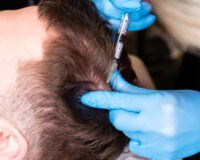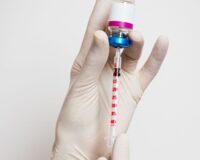Updated on 05/07/2024
Chemical peels are a well-known skin treatment and are expected to become even more popular. According to Grand View Research, the chemical peel rejuvenation market is expected to grow to $2.89 billion by 2030, a huge increase from $1,763.7 million in 2021.
This aesthetic treatment can help treat a number of skin conditions, which explains its popularity, but what are chemical peels and what does a chemical peel do for your skin?
In short, chemical peels are a cosmetic procedure that involves applying a chemical solution to the skin. Chemical peels can improve the look of the skin by reducing the appearance of sun damage, wrinkles, acne, or scarring.
We’ll cover more about chemical skin peel benefits and how they can improve your skin below.
What Are Chemical Peels?
Chemical peels are an aesthetic skin treatment that involves applying a chemical solution to the skin. This solution contains a different type of acid depending on the strength of the peel, like alpha-hydroxy, beta hydroxy, or tricholoroacetic acid.
Chemical peels aim ‘to remove dead skin cells and stimulate the growth of new cells’ to improve the appearance of many skin issues.
Chemical skin peel benefits include reducing fine wrinkles, clearing uneven skin tones, reducing acne and improving acne scars.
Each chemical peel works differently depending on their strength and how intensely they exfoliate skin.
Are Chemical Peels Safe For Sensitive Skin?
As chemical peels involve applying acid to skin, you might wonder: are chemical peels safe for sensitive skin?
The answer is yes – but you need to make sure your dermatologist takes your skin sensitivity level into account before the treatment. Chemical peels can cause peeling and redness, which may be worse on delicate skin.
Milder skin chemical peels with gentler acids in lower concentrations better for sensitive skin, like lactic-acid, a gentle type of alpha-hydroxy acid. Your aesthetic practitioner will be able to work out which skin peel types are best for you.

Different Types of Chemical Peels
There are various types of chemical peels with varying degrees of strength, depending on the skin issue you’re trying to treat.
Superficial Chemical Peels
Superficial (also known as light) chemical peels are great for lightly exfoliating the skin, as this type of chemical peel is only designed to remove the epidermis (top layer of skin). Your skin will take anywhere from a day to a week to fully heal.
Common superficial chemical peel ingredients include alpha hydroxy acids and beta hydroxy acids, like lactic acid, glycolic acid, and maleic acid.
Medium Chemical Peels
Medium chemical peels are slightly stronger than light chemical peels and involve removing the epidermis as well as the top layer of the dermis. Your skin will take anywhere from 7 to 14 days to heal when receiving this treatment.
Common medium chemical peel ingredients include trichloroacetic acid (TCA) and glycolic acid (in deeper concentrations compared to light chemical peels).
Deep Chemical Peels
Lastly, deep chemical peels are the strongest type of chemical peel and work to remove your epidermis as well as the upper and middle dermis layers.
Deep chemical peel ingredients include mixes of phenol and croton oil, as well as TCA concentrations above 50%. When it comes to this type of chemical peel, a local anaesthetic and sedative might be required to reduce any pain.
Additionally, as deep chemical peels are stronger, they involve more specific aftercare advice. It can take up to 14 days for the swelling following a deep chemical peel to reduce, but this can vary between individuals.
Poorly delivered deep skin peels can lead to scarring, infections, or burns, so they should only be carried out by qualified practitioners.

Deep chemical peels are the strongest type of chemical peel and work to remove your epidermis as well as the upper and middle dermis layers.
Chemical Skin Peel Benefits
Now you know what chemical peels are, but what does a chemical peel do for your skin?
Chemical skin peel benefits include, but are not limited to:
- Reducing acne scars
- Clearing hyperpigmentation
- Improving ageing skin
- Brightening dull skin
1. Acne Scars
The first skin issue a chemical peel can help with is reducing the appearance of acne scars.
Considering that ‘over a third (34%) of UK adults have suffered from acne at some point in their life’, acne scars are a common problem many people experience in their lives.
Acne scars occur when the skin works to create new collagen fibres to repair the lesions created by the skin condition.
Light and medium chemical peels can help to improve the appearance of acne scars by exfoliating the top layer of skin, leaving a smooth, rejuvenated layer of skin.
2. Hyperpigmentation
Hyperpigmentation leads patches of skin to become darker than the skin surrounding it. This happens when the skin creates excess melanin, the pigment which gives skin its colour.
In addition to acne scars, chemical skin peel benefits include clearing forms of hyperpigmentation. For instance, chemical peels can help to improve everything from sun damage to freckles to melasma.
A chemical peel thus helps to even out both skin tone and texture, allowing you to feel confident with and without makeup.
If you’re struggling with a form of hyperpigmentation, a chemical peel applied by a qualified aesthetic practitioner might be a suitable solution for you.
3. Ageing Skin
Chemical skin peel benefits also include reducing fine wrinkles and the appearance of ageing skin.
From age spots to fine lines and wrinkles, it’s expected and natural for our skin to become more weathered as we age.
Chemical peels not only minimise the signs of ageing but also ‘stimulate new epidermal growth and collagen’, providing you with a more youthful and aesthetic look.
That said, as they’re not recommended for deep wrinkles, chemical peels are better used as a preventative measure for fine lines and wrinkles.
4. Dull Skin
Lastly, as well as treatments such as dermaplaning, chemical peels can significantly help if you have dull skin.
Dull skin can be caused by a variety of things, from lifestyle choices to dead skin cell buildup to dehydration.
A light chemical peel works to remove the epidermis, and in doing so, reveals healthy-looking skin in its place. This gives you the glowy and rejuvenated complexion you’re looking for.
Whatever the reason you’re seeking a chemical peel, you must research and choose an established aesthetic clinic before getting this treatment.

Chemical peels not only minimise the signs of ageing but also ‘stimulate new epidermal growth and collagen’, providing you with a more youthful and aesthetic look.
We hope that this article has given you a greater understanding of chemical skin peel benefits and answered what does a chemical peel do for your skin.
You Can Clinic is one of the UK’s leading providers of aesthetic training courses and pharmaceutical supplies. Over 1000 individuals have progressed through our affordable programmes, which provide comprehensive coverage of all relevant aesthetic procedures.
Do you see yourself in the aesthetics industry? Check out our articles on Botulinum Toxin, Weight Management and Dermaplaning Training Courses.
Written by Jemima, for You Can Clinic.




